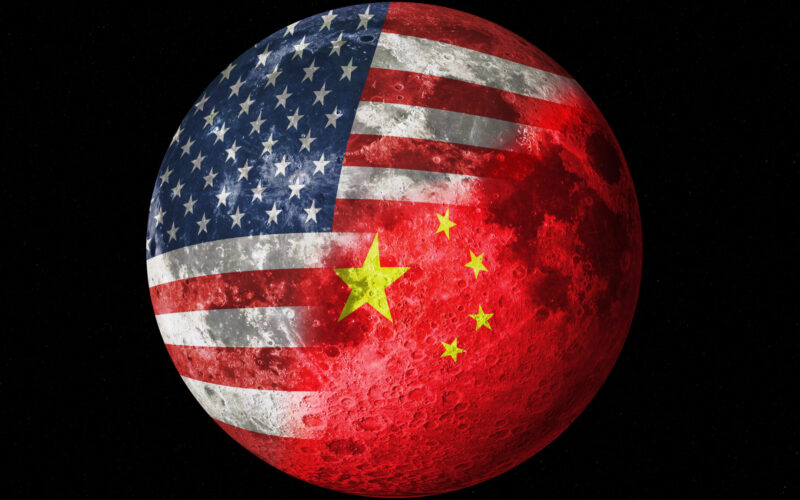In the history of human achievement, the exploration of space stands as one of the most ambitious and consequential endeavors – and has been rife with competition.
But in more recent years headlines have indicated the rise of a new “space race”, this time between the United States and China, and recent developments from both countries have received coverage from the world’s media.
It is certainly a compelling narrative, and one reminiscent of the Cold War era, but just how accurate is it?
The race to put a man on the Moon
Convinced by the political need for a decisive demonstration of America’s space superiority, United States President John F. Kennedy tasked Vice President Lyndon B. Johnson with identifying a singular achievement that could put the US ahead of the Soviets in the realm of space exploration.
More than 35,000 Americans gathered at Rice University in Houston, Texas in 1962, just a year after the Soviets sent Yuri Gagarin into space, to be reassured of the nation’s dominance in the space race.
“We choose to go to the Moon,” Kennedy declared to the crowd. “That challenge is one that we are willing to accept, one we are unwilling to postpone, and one which we intend to win.”
It took seven years but in 1969 NASA’s famous Apollo 11 mission finally landed the first human on the Moon. This accomplishment marked the US’ victory in the space race.
The race was largely about reaching symbolic milestones. After the Soviet Union was first to launch the satellite Sputnik 1 in 1957 and the first to send a human into space in 1961, the US had also managed to reach a previously unachievable goal.
A new participant in the Space race
China entered the space race on October 15, 2003, with Shenzhou 5, its first manned mission. The mission successfully sent astronaut Yang Liwei into orbit for 21 hours, making China the third country to put a person into space.
But the stakes for space exploration are much bigger than national pride and technological prowess. Today there is a greater emphasis on establishing a sustainable human presence in space. The focus is on a wider range of objectives, including scientific discovery, economic development (such as mining asteroids and the Moon for resources), and national security, with space being increasingly seen as a potential military domain.
China’s ambitious plans for its space program have attracted global attention, with 64 orbital rocket launches in 2022 and a further 60 scheduled for 2023.
On January 1, 2023, NASA voiced concerns that China could claim lunar resources under the guise of scientific research. “It is a fact: we’re in a space race,” warned NASA administrator Bill Nelson during an interview with Politico.
The claims were rejected by China. “Outer space is not a wrestling ground,” Liu Pengyu, spokesperson for the Chinese Embassy in Washington said in a statement, as reported by Politico, adding that US officials had “spoken irresponsibly to misrepresent the normal and legitimate space endeavors of China”.
The quest for Moon water
The presence of water on the Moon is a significant factor in future space colonization and exploration efforts. Water is not only vital for sustaining life but can also be separated into hydrogen and oxygen through electrolysis, providing breathable air and potential rocket fuel.
Geological samples returned by the Apollo 11 crew have given researchers the opportunity to directly look for signs of water on the Moon. Explorers brought back 382 kilograms (about 842.16 lb.) of Moon rocks, which revealed no sign of water. NASA scientists concluded that the lunar surface must be completely devoid of it.
The idea of the Moon as a cosmic desert began to change in 2008, when India’s Chandrayaan-1 aircraft, carrying NASA’s M3 moon mapper, determined the presence of ice inside the Moon’s polar craters. Subsequent missions over the years have found varying levels of evidence of water across the Moon.
Eventually, in December 2022, during its mission to the Moon, China’s Chang’e-5 rover discovered tiny glass beads in the lunar dirt, where meteorite impacts had occurred, and returned them to Earth. Scientists analyzing these samples found that billions of tiny glass beads within the lunar soil contain an incredibly small fraction of water that could potentially be extracted through a heating process.
While further study is needed to determine the practicality of this method and whether the extracted water is safe to consume, NASA was still prompted to express concern on May 31, 2023, that China could potentially claim ownership of the resource-rich areas on the Moon where water has been found.
“What worries me more is that both they and we are going to land at the South Pole, where we think there is water,” NASA chief Bill Nelson told the Spanish newspaper El País. “We want to preserve those potential reserves for the international community and prevent China from coming in and saying that the water is theirs, as they have done with the Spratly Islands.”

Diplomacy, competition, and cooperation
The Outer Space Treaty of 1967 prohibits nations from claiming sovereignty over celestial bodies.
Moon exploration and research could have profound benefits for all of humanity, regardless of which nation is currently perceived as leading.
In particular, the lunar geological record serves as a valuable archive that holds key insights into the history of the inner Solar System. The Chang’e-5 lunar samples provided the scientists at the Chinese Academy of Sciences in Beijing, with a deeper understanding of the volcanic activity on the Moon. By studying the features and composition of the Moon, it is possible to uncover vital information about the origin and evolution of the Earth-Moon system.
The Pentagon has grown increasingly concerned about China’s intentions after a destructive anti-satellite (ASAT) technology test in January 2023, a practice the US banned in 2022 due to the dangerous debris it produces.
Additionally, the 1967 Outer Space Treaty does not explicitly address the issue of extracting and using space resources, and different nations have varying interpretations of what the treaty allows. The US, for instance, passed the Commercial Space Launch Competitiveness Act in 2015, which grants US companies the right to resources they extract from celestial bodies.
Therefore, it is not just about competition between nations but also involves commercial entities like SpaceX, Blue Origin, and others.
The US is not alone in this. For example, there are the “Artemis Accords”, a set of bilateral agreements between the US and, as of June 5, 2023, 25 other countries, specifically pertaining to space resources. These agreements state that the concept also known as In-Situ Resource Utilization (ISRU) with the ability to extract and utilize resources on the Moon, Mars, and asteroids will be crucial for the long-term human presence beyond Earth.
Investing in an inclusive future
Space exploration is expensive. Even though the cost of accessing space has decreased due to advancements in technology and the rise of private space companies, lunar missions remain costly.
Securing funds for space missions involves convincing a range of stakeholders about the multifaceted benefits, from scientific discoveries and national prestige to economic and educational impacts.
NASA is already looking to increase its $25.3 billion yearly budget by 7.1% and receive a total of $27.2 billion for 2024, split mainly between human exploration and robotic science programs. NASA’s Artemis III mission has been estimated to cost between $20-30 billion over five years, not including the costs of the associated Space Launch System rocket and Orion capsule development.
The Artemis program is an example of the ‘new age’ of lunar missions, highlighting the importance of international and commercial partnerships and reflecting a broader trend of increasing inclusivity and representation. NASA’s upcoming Artemis program even plans to land the first woman and the first person of color on the Moon.
With the right budget, the Artemis III mission aims to land astronauts on the Moon by 2025, whereas China has scheduled its moon landing to take place before 2030.

A new era of international space exploration
Far removed from the ideological tussle between capitalism and communism seen in the Cold War, today’s “space race”, involving two of the world’s leading economies, extends beyond mere rivalry. Instead, it encapsulates the broader understanding of the long-term benefits of space exploration, rendering the term “race” somewhat inaccurate.
Rather than being a race between two global powerhouses, current space exploration involves a variety of players, including multiple countries and private companies, each playing a significant role in space exploration and commercialization.
The post-Cold War era was marked by an increasing emphasis on international cooperation in lunar exploration. This was reflected in initiatives like the International Lunar Exploration Working Group (ILEWG), established in 1995, and the Global Exploration Roadmap (GER), released in 2011, which involve multiple space agencies working together to coordinate their lunar exploration plans.
However, cooperation between China and the West in space has been hindered since 2011 due to US legislation, often referred to as the “Wolf Amendment,” that prohibits NASA and the White House Office of Science and Technology Policy (OSTP) from engaging in bilateral agreements and coordination with China. This amendment was passed due to national security concerns, specifically the risk of technology espionage. Consequently, China was barred from joining programs such as the International Space Station (ISS).
While this legislation restricts NASA’s engagement with China, it does not prevent other forms of space-related multinational cooperation between the two countries, as long as they are not bilateral or directly funded by NASA or the OSTP. Thus, the increasing participation of the private sector in the realm of space has the potential to usher in a fresh era of multinational collaboration.

